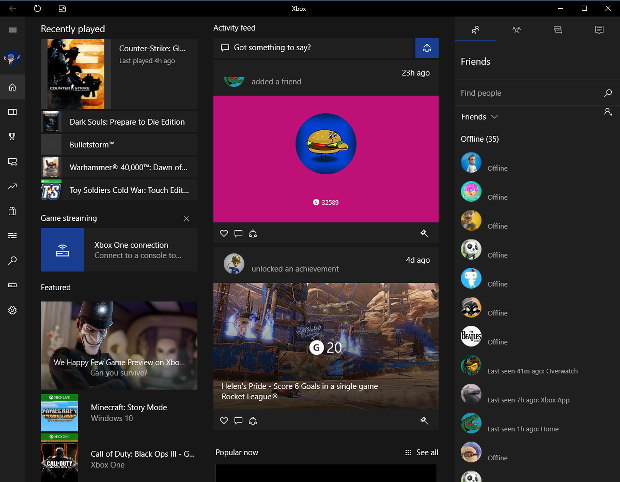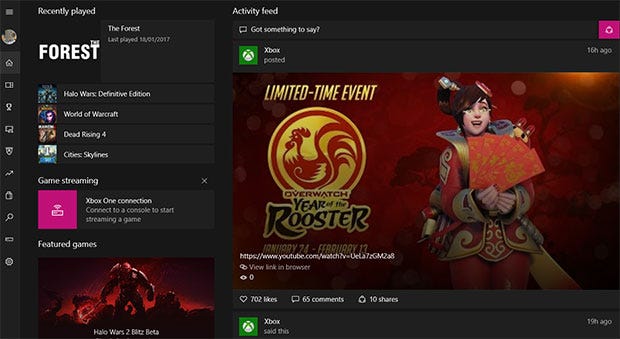Interview: Windows 10's new Game Mode explained
Can a new option in your OS really improve performance?
Just last week (and yet somehow an eternity ago, in terms of world events), Microsoft announced that they'd soon be adding something called 'Game Mode' to Windows 10 with the aim of improving games' performance, but gave away few details about what this might involve. Are we talking real framerate gains, suppressing potentially bothersome background tasks or just freeing up a wee bit of RAM?
With the first iteration of Game Mode due to arrive as part of Windows 10's optional early Insider builds due today, I had a chat with Kevin Gammill, Partner Group Program Manager, Xbox Platform, spokesperson for the group building Game Mode, to find out what this thing actually does, which games it will support and what kind of control users will have over it.
I'll run the interview itself first, but underneath are a few quick thoughts from me on what I think this might all mean.
RPS: What's the basic thrust of Game Mode?
Kevin Gammill: Game Mode's a feature that we're adding with the Creator's Update in Windows 10. Our goals with Game Mode are pretty straightforward. It's really about making Windows 10 the best operating system to play your games. We kind of look at that with two different lenses. One is both what I'll call increased framerates for getting more performance out of the box, but the other one that I'd argue is probably more important is a more consistent gaming experience as you play your game. I don't know if you're a core gamer, I am; there have been many times where I'm in a game and I'm update against the final boss fight or whatever you want to call it, and because of what's going on in the game I get a drastic reduced framerate and things start to get a little bit laggy. Providing a more consistent experience throughout the entire gameplay is also kind of an important feature of game mode.
RPS: Is this with something that will apply just to Windows 10 games or all games?
Kevin Gammill: Basically, I think you're asking 'will Game Mode only work for UWP-based games or will they also work for Win32 games?" Absolutely it will work for both. I do want to say that Game Mode will likely see a slightly better performance increase in UWP-based games, simply because we know the boundaries of the game. The way the operating system works and the way Win32 works, we really don't know where the game starts and ends from a system level perspective, whereas with UWP we do. Because we know those boundaries better in UWP, we're likely to be able to afford the game slightly better performance increases. But it absolutely works with both Win32 and UWB-based games.
RPS: Is that legacy as well? Not just DirectX 12 stuff?
Kevin Gammill: Correct. Absolutely. If you have a game that still runs on your Windows 10 machine that's 15 years old, Game Mode will absolutely work with it.
RPS: I was told in advance that you wouldn't be saying too much about the nitty and gritty of performance gains just yet, but clearly that's what most people are concerned with here. I've seen speculation that all it will do is suspend background tasks to free up a little more memory - any truth to that? And can it do anything to improve GPU performance specifically?
Kevin Gammill: OK, great, I'll go there. I want to keep this at a relatively high level because we're short on time here, but what I'd love to do with you guys is go on to the depths on a future call, but I will touch a little bit on your questions now.
With the Creator's Update and Game Mode right now, we're primarily focused on biasing the game versus the rest of the operating system, from a GPU and CPU perspective. So for some of the other system resources, we can get into a roadmap discussion on the next call, but really right now Game Mode is about biasing the game from a GPU perspective so it gets more of the cycles if it's in the foreground, and from a CPU perspective both biasing to get more CPU cycles as well as avoiding what I'll call thread contention for the game.
 The current UI overload that is the Xbox app in Windows 10 - not actually related to Game Mode per se, but hey, we had to illustrate this piece somehow
The current UI overload that is the Xbox app in Windows 10 - not actually related to Game Mode per se, but hey, we had to illustrate this piece somehow
RPS: Can you give a ballpark on the kind of performance boosts you've seen from this so far?
Kevin Gammill: I'll touch on that a little bit. Yes, is the short answer. Kind of the way I look at it is that any increase is a benefit, without question. Even it's as low as, say, a 2% increase in framerate, if you're running a hundred frames per second, I will take those extra two frames per second without question. Two percent is pretty significant when you're playing your game.
A specific answer to your question is that it's probably too early in testing to give you a good idea where we'll land. Basically of the broad configuration of PCs out there, both from a hardware perspective as well as from existing software running on those systems perspective, and then you throw in a variety of different games... We're still doing a lot of testing and getting telemetry on how those results come back. So it's really too early to tell, but the early results definitely look positive.
RPS: How does it operate in terms of the UI and automation? Does it kick in by itself or is essentially extra faff before running your game?
Kevin Gammill: It's a little bit of both. At any time a user can call up the Game Bar and enable Game Mode for any title or game they would like. That's kind of option one. And then at the same time we will have what we call kind of an approved list or whitelist of games that we feel super-comfortable about and we want to enable out of the gate. Those will be turned on by default. It's a little bit of both. The user has full control to turn it on or off, that's up to them on any game. And then we will have a list of games we know Game Mode works really well with, and that list will continue to grow over time, where it will be automatically enabled unless a user decides to turn off Game Mode.
RPS: How will those updates work? Automated or manual?
Kevin Gammill: It'll be transparent to the user. We maintain a list - we call it the Known Games List - internally for both Game Mode and other game-related features, and that gets updated on a regular basis.
RPS: Is this comparable to how new graphics card driver updates have new profiles for new games?
Kevin Gammill: Yup, that's a good analogy.
RPS: A lot of people have a Netflix stream or a podcast playing or they're streaming themselves while they play a game - what risks are there that Game Mode will interfere with that? I know they can just turn it off but it's still a back and forth.
Kevin Gammill: At the end of the day, if your machine is being fully-taxed it is a zero sum game. The amount of total GPU resources, for example, that you have on your system, is capped at a certain value. If you have a game running in the foreground and you have Lightroom running in the background crunching some video, you'd expect that to slow down if you have the game in the foreground running Game Mode. Absolutely, because we will bias the game that in in the foreground to have more of the GPU cycles than normal.
RPS: What about stuff that's not specifically GPU-y, like video streams or music?
Kevin Gammill: If that is running in the background, depending on your system configuration, what machine you have, the amount of resources that you have, how much the game is taxing your system and the other software that you have running on your computer for that matter. Depending on that, there's a chance that whatever you have running in the background does slow down because of what you've done. That should not be surprising, because it really is a zero sum game.
RPS: Is there any scope to additionally whitelist non-game applications?
Kevin Gammill: I think we should talk about that on our next call. That answer is there is a more complicated roadmap question, but it's certainly something we're considering. A good example for a lot of people is that they'll have YouTube up and running as kind of a tutorial while you're playing the game. That's a scenario we want to be very thoughtful. We should probably talk about that more later.
The other thing I'll point is that we absolutely are working with IHVs (independent hardware vendors, specifically AMD, NVIDIA and Intel in this case - Acronymnonious Ed) on this. We're working closely with IHVs on helping us to tune this even further.
RPS: We're not going to see anything favouring the green team over the red team or vice-versa?
Kevin Gammill: No, not at all. Not at all.
RPS: Just to confirm, by 'Game Mode' we are talking about purely a performance thing, not that the UI somehow switches to something alternate form?
Kevin Gammill: Correct. At this point, it is more low-level than that.
RPS: What game-related features are you looking at outside of performance? For instance, we've had some frustrations about how limited the control we have over games installed via the Windows store are - where they install to, even how to access the files.
That's outside my engineering area,. It's a good question, and I apologise for not knowing the answer, but my team doesn't handle that.
RPS: Do you feel that, once you've got these profiles coming in and a baseline of functionality, that's what Game Mode is? Or can we hope for far more significant performance gains later on?
Absolutely. We have quite a roadmap built up for Game Mode, and our next conversation I would love to tell you more. We have easily a year's worth of work we could do for continual improvements to Game Mode we want to make.
RPS: What was it, broadly speaking, that made you do this? From the outside looking in, Windows has been fairly quiet about games despite occasional statements to the contrary. How much more significant a push is this one, and why?
I would argue that it's been more subtle, but we've continued to do work, at least with Windows 10, on improvements for games. A good example for that is shipping DX12 about two years ago. A game that adopts DX12 - huge performance increase, lower power draw etcetera. It's not like we've ignored gaming up until now, but more specifically to answer your question - I have come more from the console side of the business. Those machines are dedicated gaming boxes, obviously, and we have a learned a lot in fine-tuning the operating system for the original Xbox, Xbox 360, Xbox One and soon to be Scorpio. We've taken some of those best practices, and we're starting to apply those more broadly across more Windows devices. Game Mode's an incarnation of that.
RPS: What degree of crossover is there between this and DirectX? Do they remain separate projects and separate teams?
We work very closely with the DirectX team, but this is more of a parallel work effort. This doesn't bias the game better or worse depending on what version of DirectX you're running. That is independent of how Game Mode works.
RPS: I was more wondering if it will affect the future of DirectX if this is potentially the future of Windows for gaming.
That's probably a better roadmap conversation. Once I open that door, we have a very long conversation.
RPS: Thanks for your time.
Closing thoughts of my own, then? Real deep-down detail on what this does and how it really works is yet to come, but the main takeaway I had was that it may be focused on the aggressive suppression of other tasks so as to not steal performance from the game. This may well be useful - I've had situations where e.g. Windows' antimalware tools suddenly start chewing up a bunch of CPU time because they're not sure what some application or service is, or some third-party application or the other decides it wants to update itself at precisely the wrong moment.
Something Kevin asked me outside of the interview was if I knew what he meant in terms of consistency of performance as opposed to performance itself, and yeah, sure, I've certainly known situations where things briefly go haywire because something other than game starts screaming for attention in one way or another. A few headaches might be saved if that kind of thing can be blocked.
Actual graphical performance boosts I'm less sure about, however. Certain applications, such as Photoshop or video streaming, can tie up GPU time even in the background, so maybe there are situations whereby ensuring that the game has absolutely nothing denied to it will help, but it's hard to see right now how this could go all the way to a meaningful improvement at all times.
But maybe Game Mode can help to stop Windows itself from troubling the graphics card when it's otherwise engaged - for instance, how Windows Shell Experience Host handles graphics for 'Modern' apps and controls rotation of desktop wallpaper. Various tiny background things that might minutely distract the GPU; as he says, a 2% performance gain might not be a big number, but there are certainly cases where it's enough to make a difference. I mean, if you're using Vsync, two or three fewer frames per second can be enough to drag the framerate lock down from 60 to 45 or even 30.
Anyway: I'll give Game Mode and spin once it's available, and see what difference it's actually making to games on my system.
The first iteration of Windows 10 Game Mode is due to be made available later today, but for the time being requires opting into potentially raw and buggy Insider builds via Windows Update. It will see a wider public release as part of the forthcoming Creators Update for Windows 10. This update does not have an official release date as yet, but is rumoured to arrived in April.














